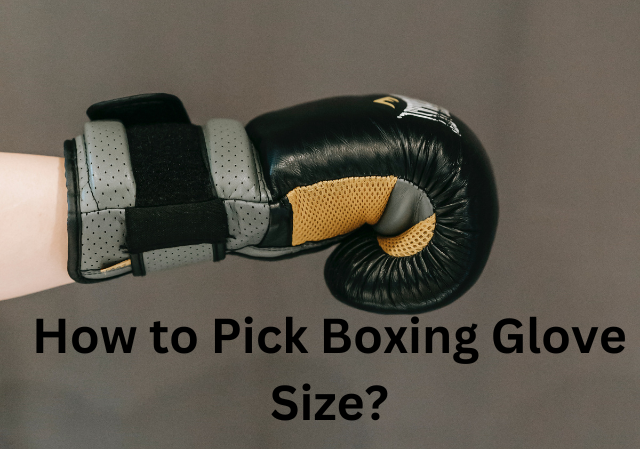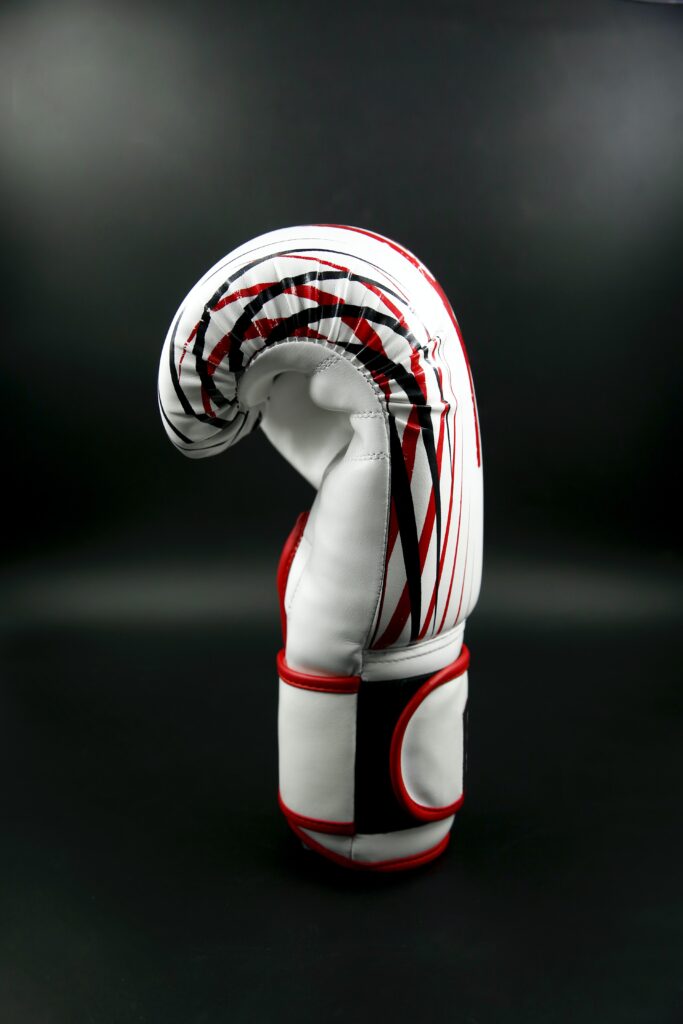Boxing is a physically demanding sport that requires proper equipment to ensure safety and maximize performance. Among the essential equipment for any boxer, boxing gloves play a crucial role in protecting the hands and minimizing the risk of injury.
However, selecting the right boxing glove size can be a daunting task, especially for beginners. Here the questions comes in play How to Pick Boxing Glove Size?

In this article, we will guide you on how to pick the perfect boxing glove size to enhance your training experience and performance in the ring.
Importance of Choosing the Right Boxing Glove Size
Selecting the right boxing glove size is crucial for several reasons. First and foremost, it ensures the safety of both the wearer and their training partners.
Gloves that are too small can lead to hand injuries, while oversized gloves can reduce the impact and effectiveness of punches.
Additionally, the right glove size can provide better wrist support, reducing the risk of sprains or fractures.
5 Factors to Consider When Choosing Boxing Glove Size
When determining the appropriate boxing glove size, or choosing best boxing glove several factors should be taken into consideration:
1. Weight and Purpose
The weight of the gloves is an essential factor to consider. Different glove weights are suitable for various training purposes.
Heavier gloves, such as 16 oz, are typically used for sparring and competition, while lighter gloves, such as 10 oz or 12 oz, are more common for bag work and speed training.
2. Hand Size and Wrapping
Hand size is another critical factor in choosing the right glove size. Measuring the width and length of your hand can provide valuable insights into the size range you should consider.
Additionally, if you wear hand wraps during training, make sure to measure your hand with the wraps on to ensure a proper fit.
3. Closure Type
Boxing gloves come with different closure types, including Velcro straps and lace-ups. Velcro straps offer convenience and easy adjustment, while lace-ups provide a more secure and customizable fit.
Consider which closure type suits your preferences and needs.
4. Comfort and Fit
Comfort is paramount when selecting boxing gloves. They should fit snugly but not restrict movement or cause discomfort.

The thumb should be positioned correctly, and the gloves should offer adequate padding and support to the knuckles and wrists.
5. Brand and Quality
Choosing reputable brands known for producing high-quality boxing gloves is essential.
Brands with a track record of manufacturing durable and reliable gloves should be preferred, as they ensure longevity and performance.
Measuring Your Hand for the Right Boxing Glove Size
Before diving into the various boxing glove sizes, it’s crucial to measure your hand accurately. This will provide a baseline for selecting the appropriate size. Here’s how you can measure your hand:
Here check out boxing glove deodoriser.
Measuring Hand Width
Take a flexible measuring tape and wrap it around the widest part of your hand, just below the knuckles. Make sure the tape is snug but not too tight. Note down the measurement in inches or centimeters.
Measuring Hand Length
Measure the distance from the base of your palm to the tip of your middle finger. This measurement will help determine if your hand size falls within the standard ranges for different boxing glove sizes.
Understanding Boxing Glove Sizes
Boxing gloves are categorized based on their weight, typically measured in ounces (oz). It’s essential to understand the different weight classifications and their common sizes:
Oz and Weight Classifications
- 8 oz: Generally used by professional fighters in weight classes below 135 pounds.
- 10 oz: Commonly used in professional fights between 135 to 160 pounds.
- 12 oz: Ideal for training purposes and used in most boxing gyms.
- 14 oz: Suitable for sparring and training among fighters in weight classes above 160 pounds.
- 16 oz: Standard size for sparring and competitions, especially for heavyweight boxers.
Common Boxing Glove Sizes
Besides the weight classifications, boxing gloves are available in various sizes to accommodate different hand sizes. Common sizes include small, medium, large, and extra-large.
These sizes often correspond to the hand circumference, so it’s crucial to refer to the manufacturer’s sizing chart to find the most accurate fit.
Selecting the Appropriate Boxing Glove Size
Once you have a good understanding of the weight classifications and your hand measurements, it’s time to select the appropriate boxing glove size based on your needs:
Training Gloves
For general training purposes, such as hitting bags or mitts, gloves in the range of 12 oz to 16 oz are suitable. The selection depends on your body weight and personal preferences.
Heavier gloves offer more protection and simulate the weight of competition gloves, while lighter gloves can enhance speed and agility.
Sparring Gloves
Sparring requires specific gloves to ensure the safety of both participants. It is recommended to use gloves in the range of 14 oz to 16 oz for sparring sessions.

The extra padding in these gloves provides added protection during controlled training bouts.
Competition Gloves
When it comes to competitive fights, the glove size is usually dictated by the rules and regulations of the specific event.
It’s essential to check with the organizing body to determine the required glove size for your weight class. Commonly, professional fighters use gloves ranging from 8 oz to 10 oz, while amateurs usually wear 10 oz or 12 oz gloves.
Trying on Boxing Gloves
Once you have narrowed down your options, it’s crucial to try on the gloves before making a final decision. Follow these steps to ensure a proper fit:
Ensuring Proper Hand Wrapping
Before putting on the gloves, wrap your hands as you would during a training session. This will replicate the actual fit and feel when wearing the gloves during workouts or fights. Hand wraps provide additional support and protection to the hands and wrists.
Testing for Comfort and Mobility
Put on the gloves and fasten them securely. Flex your hands, make a fist, and move your fingers to assess comfort and mobility. The gloves should allow natural movement while providing adequate support and protection. Pay attention to any areas that feel tight or restrictive, as this could indicate an improper fit.
4 Common Mistakes to Avoid
When selecting boxing glove sizes, it’s essential to avoid common mistakes that could compromise your safety and performance:
Choosing Gloves Too Small
Opting for gloves that are too small can result in discomfort, restricted movement, and increased risk of hand injuries. Make sure to refer to the sizing charts and measurements to ensure a proper fit.
Opting for Gloves Too Large
On the other hand, gloves that are too large may not provide adequate support and protection. They can affect your punching technique and reduce the effectiveness of your strikes. Avoid choosing oversized gloves that compromise your performance.
Neglecting Hand Wrapping
Hand wraps are a crucial component of wearing boxing gloves.
Neglecting to wrap your hands properly can lead to instability, increased risk of injury, and discomfort. Always wrap your hands before putting on the gloves to ensure maximum support and protection.
Ignoring Closure Types
Different closure types, such as Velcro straps or lace-ups, offer different levels of adjustability and security. Consider your preferences and needs when selecting the closure type for your boxing gloves.
Maintaining and Caring for Boxing Gloves
To ensure the longevity and performance of your boxing gloves, proper maintenance and care are essential:
Proper Cleaning and Drying
After each training session or fight, wipe down the gloves with a clean cloth to remove sweat and debris. Avoid submerging the gloves in water, as it can damage the padding and affect their shape.
Allow the gloves to air dry thoroughly before storing them.
Storage Tips
Store your boxing gloves in a cool, dry place away from direct sunlight. Hanging them or using glove deodorizers can help maintain freshness and prevent odor buildup.
Avoid storing them in damp or humid environments that can promote bacterial growth.
FAQs
Can I use the same gloves for training and sparring?
It’s generally recommended to use different gloves for training and sparring. Training gloves are designed for bag work, mitts, and general training, while sparring gloves offer more padding and protection for safe sparring sessions.
Are hand wraps necessary when wearing boxing gloves?
Yes, hand wraps are crucial when wearing boxing gloves. They provide additional support, stability, and protection to the hands and wrists, reducing the risk of injuries.
How often should I clean my boxing gloves?
Ideally, you should clean your boxing gloves after every training session or fight. Wiping them down with a clean cloth and allowing them to air dry will help maintain hygiene and prevent odor buildup.
Can I borrow or share boxing gloves with others?
It’s not recommended to share boxing gloves with others due to hygiene reasons. Each individual’s gloves should fit their hands properly to ensure a comfortable and safe training experience.
Where can I buy boxing gloves?
Boxing gloves can be purchased from sporting goods stores, online retailers, or specialized boxing equipment stores. Make sure to choose reputable brands and consult the sizing charts before making a purchase.
Conclusion
Choosing the right boxing glove size is crucial for both safety and performance in training and competition.
By considering factors such as weight, hand size, closure type, comfort, and brand quality, you can find the perfect gloves that suit your needs.
Remember to measure your hand accurately, try on different sizes, and prioritize proper hand wrapping. Taking care of your gloves and avoiding common mistakes will ensure they last longer and provide optimal protection.






